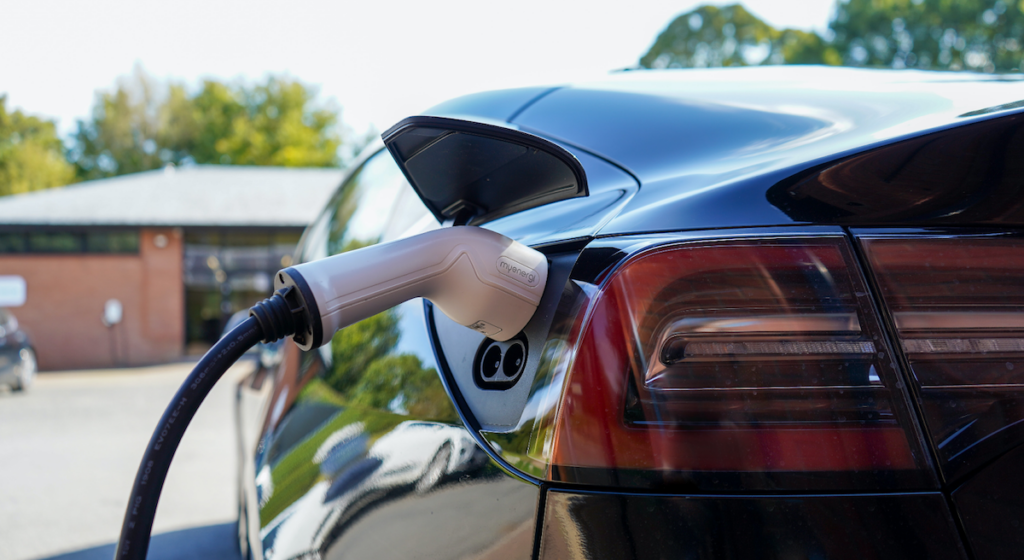
If you are planning on buying an electric car or you just bought one, you’re probably wondering how you will charge your electric car at home. While not quite as easy as plugging in your cellphone at night—with a little planning you can make sure you have the proper home setup to charge quickly, easily, and affordably in your garage or driveway.
Here’s how to charge your electric car at home:
1. Decide Which Level Charger You Need
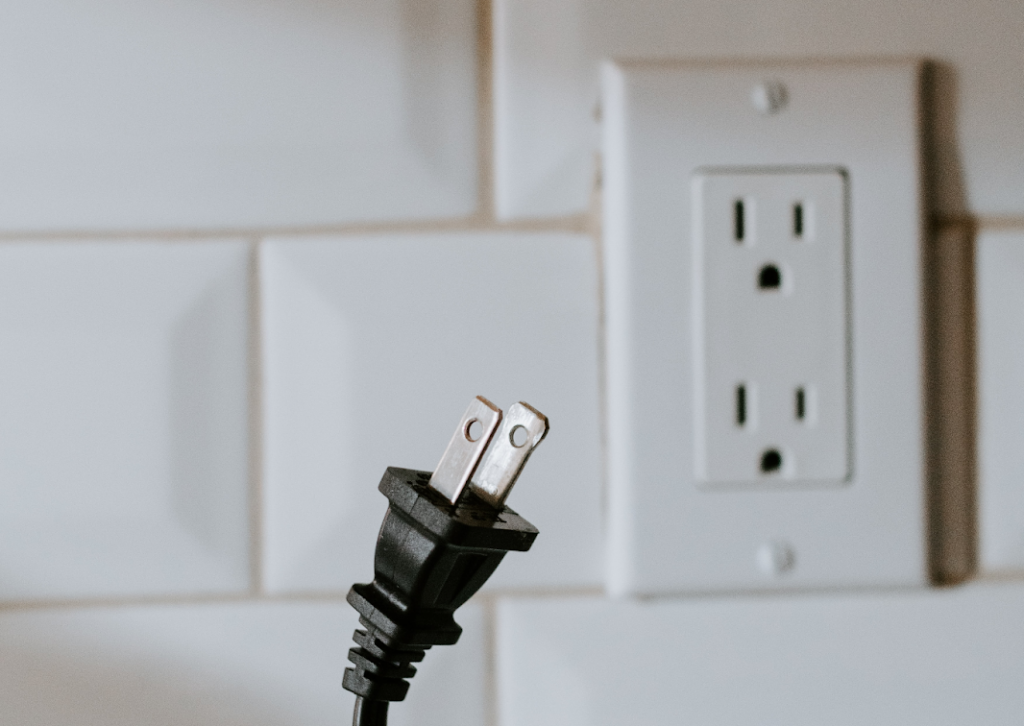
Most electric cars come with a Level 1(120-volt) charger when you purchase the car. This is the same type of charger you use for most standard home appliances like your computer and toaster and is plugged into a standard 120-volt wall outlet.
While Level 1 chargers are easy and familiar, the obvious drawback is they are slow and will take 12-18 hours to fully charge your car. That’s why most experts, myself included, would recommend upgrading to a Level 2 Charger so you can charge your car in half the time.
How Much Do Level 2 Chargers Cost?
The cost of a Level 2 EV Charger is between $400 and $1,000 and it’s important to note that this doesn’t include the cost of installation. Of course, you can just go onto Amazon and buy the first reasonably priced Level 2 Charger that pops up. However, to create the best setup for your precious new EV you need to consider all your options and the installation process before making the right purchase for you.
Level 2 Charger Plug Type
In the US, the industry has settled on a standard Level 2 charging plug called the J1772. Of course, this doesn’t apply to Tesla which uses a proprietary plug style. However, Tesla owners can purchase a J1772 adapter to charge their Tesla with a standard Level 2 charger.
To help you narrow your Level 2 charger options, we created The Ultimate Level 2 Charge Buyer’s Guide. You can review this list to find the right fit for you. But before you buy, be sure to read our entire article to learn why you need to schedule a consult with a local electrician or installation expert.
2. Consult an Electrician or Level 2 Charger Installation Expert
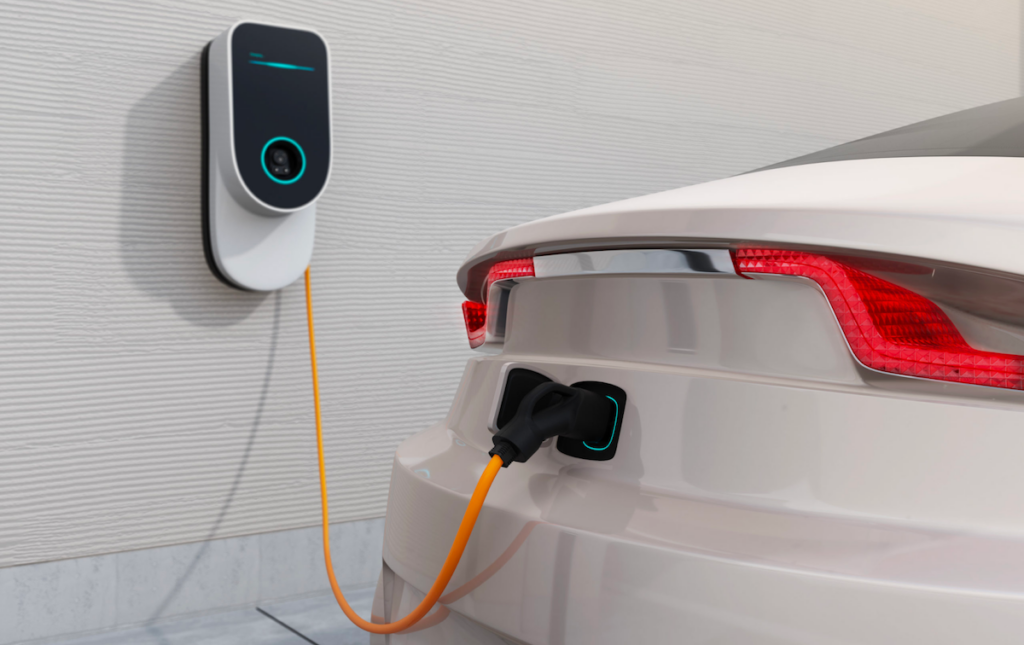
There are many things that you may need to discuss with a Level 2 EV charger installer or electrician prior to purchasing your charger. The installer or electrician should be familiar with the Level 2 Charger you are considering.
The three main concerns for you to consult with them before making your Level 2 purchase are:
Location of Your Home’s Electrical Panel
One overstated factor in where you mount your Level 2 Charger is the location of the electrical panel. While this is important to the installation of your Level 2 Charger, it shouldn’t be the reason to mount the charger in an inconvenient or unsafe location.
The additional cost to run the extra wires or even a subpanel will be small in comparison to having your charger in a safe, dry, and convenient location.
Electrical System Requirements
Many new EV owners have learned that the electric demands of their new car surpass the capacity of their home’s electrical system. Many older homes don’t have the ability to handle the 32-50amp draw from a Level 2 charger.
In some cases your electrical panel may need a separate fuse, some may need a subpanel installed, and others may have to upgrade their entire electrical panel costing upwards of $5,000.
Some Level 2 EV Chargers allow you to reduce the amperage to accommodate less capable electrical systems. Just note that as you reduce the amperage you will also increase the time it will take to charge your EV.
Therefore, before you commit to buying a Level 2 charger, have an electrician determine if your electrical panel can handle the charger you are considering.
Level 2 Charger Receptacle Plug and Cord
Some Level 2 EV Chargers don’t come with an attached plug so they will need to be hardwired. Fortunately, the majority of the Level 2 Chargers have a cord with a NEMA 14-50 plug (similar to an electric dryer) that must be plugged into a receptacle that will need to be installed by an electrician. The main benefit of a plug is you can easily upgrade your charger or take it with you when you move, without having to hire an electrician to unwire your charger.
The issue is each Level 2 EV Charger comes with different length receptacle cords, some as short as 12 inches. If you were to have your receptacle installed before purchasing your charger you may have to hire an electrician to move the receptacle or even rewire the charger.
Before your electrician appointment, spend a little time thinking about the ideal place to mount your charger and the ideal cord length. We’ll cover this in our next step.
3. Determine the Mounting Location and the Length of Charging Cable Needed
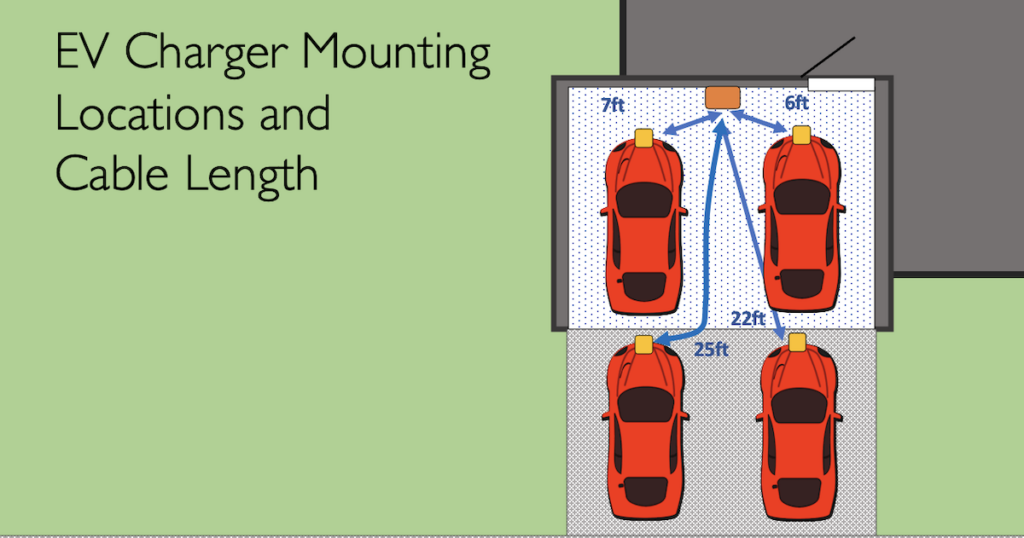
Most of the Level 2 EV chargers are wall mounted and are not meant to be portable. You MUST determine where the best mounting location is for your situation BEFORE you hire an electrician to install the 50 Amp service and receptacle necessary to power the system.
A common mistake we see electric car owners make when installing a new Level 2 EV Charging System is allowing the electrician to choose the easiest location in relation to the electrical panel. This is a short-sighted approach that has left many EV owners having to dangerously string their EV charge cords over or even under vehicles to get to their charger.
How to Determine Where to Mount Your Level 2 Charger
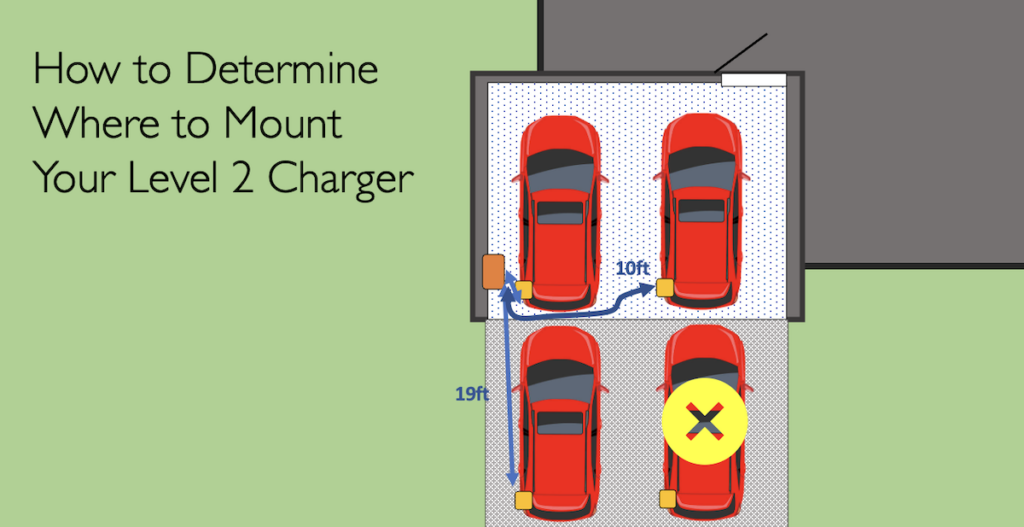
Charge cords for electric cars range from 18ft to 25ft—and it is not recommended to use an extension cord to increase the length. To determine which chord length you need, take a traditional garden hose and mark it at 18, 20, 23, and 25 ft (the optional lengths of charge cords).
Have someone hold the hose about 4ft above the ground at the proposed mounting location. Hold the other end at the charge port of your EV and at each of the possible parked locations that you may wish to charge. Keep in mind that the hose should not be taught. Once installed the weight of the cord should be rested on the ground, not pulling on the charger or the car’s charge port.
Here are some important factors to consider:
A) Charge port locations vary
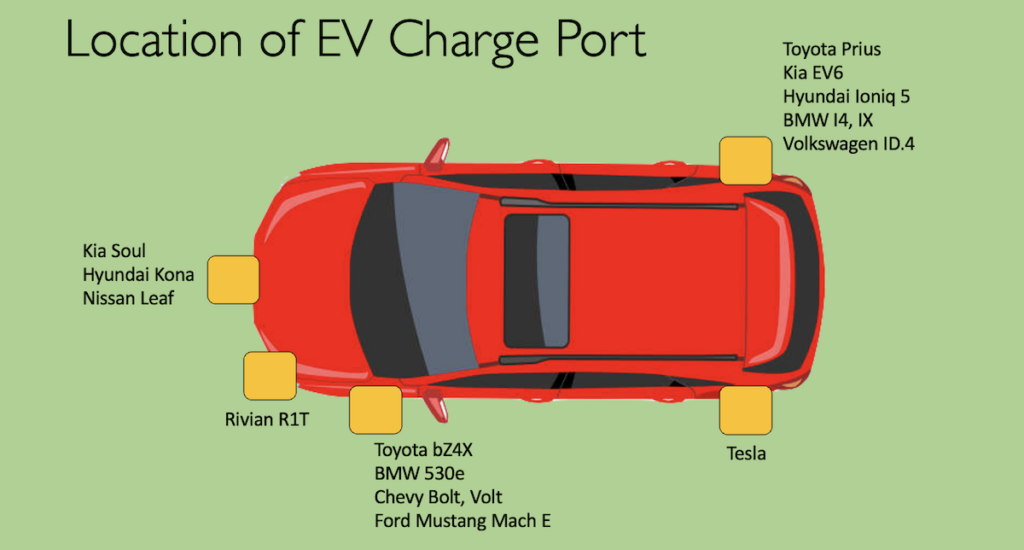
There is no standard when it comes to the location of the charging port on an electric car. The locations change between manufacturers, the models, and even the year. The Hyundai IONIQ for instance, in 2020 the charge port was located on the driver’s rear of the car, like a Tesla. However, in the 2022 model, it has moved to the passenger rear.
This makes little sense, you would think that manufacturers would want you to upgrade your model every year. It would make it much more convenient if you didn’t need to relocate your charger every time you upgraded your car. Nevertheless, before you run out and buy a Level 2 home charging system you will need to know the location of the charge port of the electric car you plan to charge.
B) You may want to account for multiple vehicles
Another thing to consider is the number of electric cars you and your family are planning to own. You don’t want to have to shuffle cars around every time you need to charge. Also, if you’re planning to charge two cars at once in the future, you may need to purchase a charger that allows for multi-car charging or even further upgrade your electrical system.
C) Will you be pulling in or backing up?
Many so-called “good drivers” (sarcastic tone) avoid backing up. My wife has an impeccable driving record, and her near-perfect Lexus rx350 Hybrid reflects that. One of the reasons may be because she never attempts to back into a parking spot. When challenged with the option to back in or park a city block away, she will always pick the latter.
If we were to upgrade her hybrid to a fully electric car, I would need to take this fact into consideration. If the new EVs charge port is located in the rear of the car I would need to ensure that the charging cable was long enough to reach the back of the garage even if the Level 2 charger was located in the front. This would allow her to pull into the garage and still be able to charge.
D) Avoid putting your charger near doors, stairs, and hazards
The last thing you must consider is the location of any doors, stairs, or other potential hazards that could cause someone to trip and fall or cause the high-voltage system and cord to be damaged or cut.
An EV charger installer once told me to never place the EV charging system on the back wall of the garage where someone (like me) could back into it. This advice came from his personal experience of having to replace home charging systems after an owner was distracted while backing in.
The location of the Level 2 EV charger should be somewhere that it cannot be accidentally hit by a vehicle or bicycle, and where the charging cords won’t be run over.
4. Consider if You’ll Be Charging Indoors or Outdoors
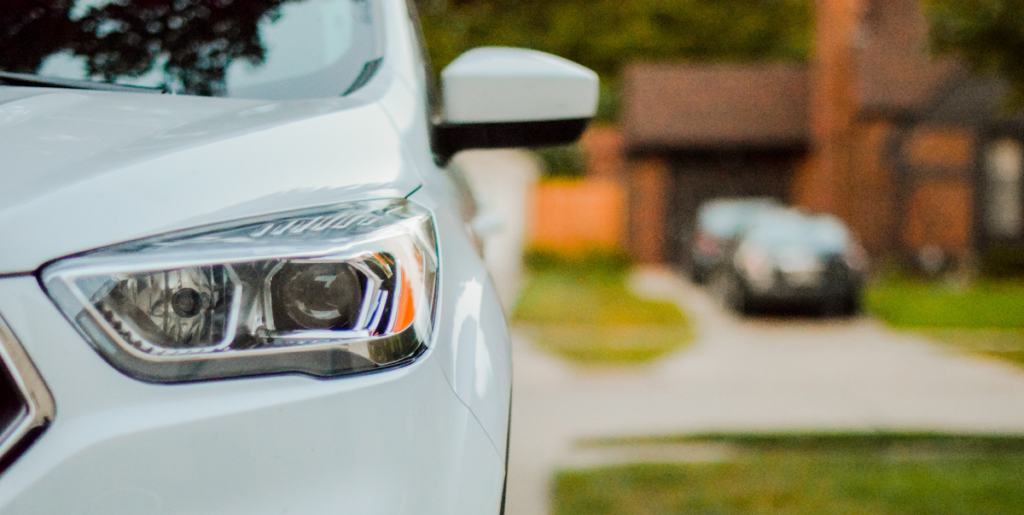
If you plan on parking your electric car outside, there are some special considerations to make. It is important that your Level 2 charging system is adequate to stand up to the weather in your area. Where I live here in Colorado, we can see feet of snow in the winters, blazing hot sun in the summers, and quite a bit of rain in the spring.
For conditions like this, you would want to make sure you purchase a high-quality Level 2 charger that is rated NEMA 3 or greater.
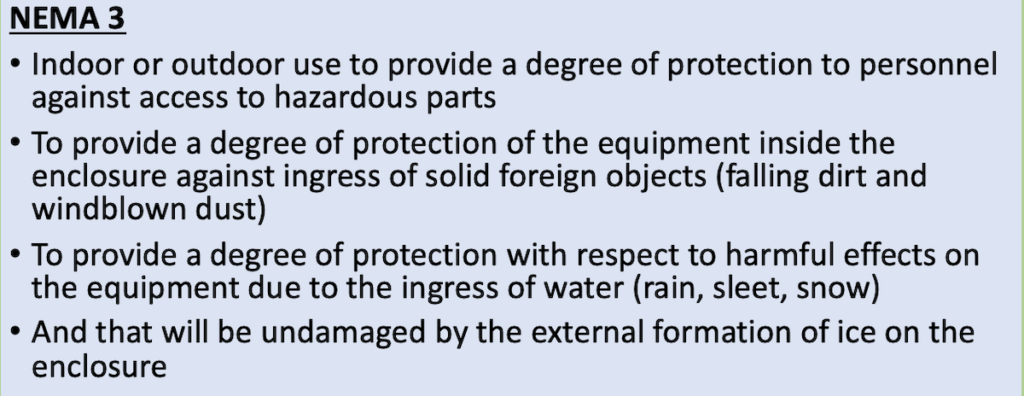
Locking Charger
Another consideration you may make if you are charging outdoors is the ability to lock the system when it’s not in use and have a locking charge plug to prevent your charger from being used without your permission.
Final Thoughts
Owning an electric car can be an outstanding new experience. But there are plenty of pros and cons to electric car ownership. Home charging an electric car can definitely feel like a con and challenging experience at first… One so distasteful it could send you back to buying a gas-guzzling SUV!
Many of the frustrations and additional costs can be avoided by understanding how home-charging works and thoughtfully planning a charging setup that works for you.
Have home-charging questions that we didn’t cover? Let us know in the comments!


Leave a Reply